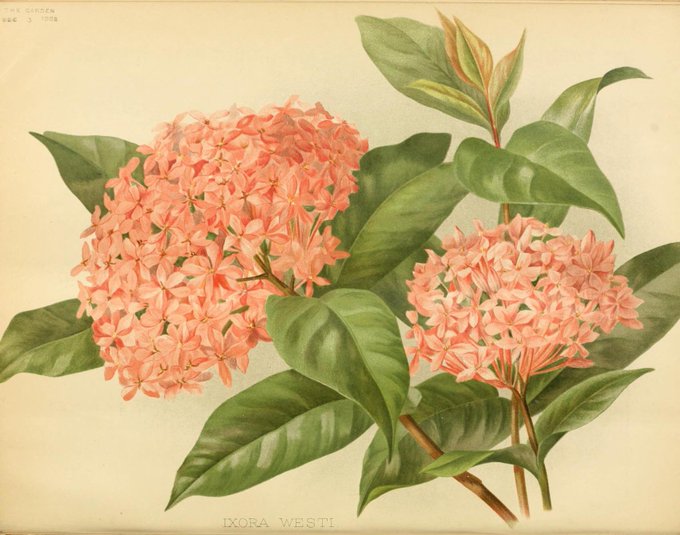hernaturalhistoryのTwitterイラスト検索結果。 214 件中 7ページ目
In Germany, Auriculas are a symbol of home. Bear's Ear Primula, Magdalena Bouchard, ca. 1773–1793. From Hortus Romanus, vol. 1, Massachusetts Horticultural Society Library. #FolkloreThursday #WomensArt #HerNaturalHistory #WomensHistoryMonth #WomenInSTEM
New #ArtHerstory guest post by @ZooLibrariANN, https://t.co/hjH8FRHz06. It discusses the work of C17th & C18th #womenzoologicalartists, incl #MariaSibyllaMerian, plus the work of a few from the C20th century, incl #LilyAtteyDaff. #hernaturalhistory @theflorajournal
Elinor Frances Vallentin collected hundreds of plant specimens from the Falkland Islands. She illustrated many of these in her 1921 work on Falkland Islands botany, which is freely available online in #BHLib via @FieldMuseum ➡️ https://t.co/N1E0DPjDtj
#HerNaturalHistory
"Canadian Wild Flowers" (1868) was one of the 1st serious botanical works in Canada. It was authored & illustrated by women — Catharine Parr Traill & Agnes Fitzgibbon Chamberlin. It is freely available online via @MuseumofNature ➡️ https://t.co/PmwELa51Bc
#HerNaturalHistory
Plant Study, n.d., by #KatharinaFreiinVonRöthlein (Austrian 1804-1833), who was born #otd. Held at the @AlbertinaMuseum, https://t.co/rXC9KwpkE9 #hernaturalhistory #womenbotanicalartists #womenartists #artherstory @HerstoryDiary @thisdateinart
Op deze #Vrouwendag stellen we graag Mary Lawrance aan je voor, een Engelse botanisch tekenaar, gespecialiseerd in het vastleggen van bloemen.
In 1799 publiceerde ze dit fantastische boek over passiebloemen.
https://t.co/u5jUKN5Noz
#HerNaturalHistory #WomensDay
Anne Pratt (1806-1893) was one of the most popular artists and writers of the “Golden Age of botanical art”. Producing 20 publications, she helped create interest in flower study in the general public. Learn more ➡️ https://t.co/sxUI5xB6vf
#HerNaturalHistory
Eleazer Albin’s 'A Natural History of Birds' (1738-40) was the first British printed book of #ornithology to feature hand-coloured plates. In fact many of the 300 illustrations were the work of his daughter Elizabeth. #HerNaturalHistory #IWD2020 #InternationalWomensDay
Margaret Meen (1755-1824) was an English watercolour artist and teacher.⠀
In 1790 she published “Exotic plants from the Royal Gardens at Kew” in 1790. https://t.co/y4vCnisDP1
⠀
#HerNaturalHistory #womensday #vrouwendag
Happy #MycologyMonday! The European blusher (Amanita rubescens) is so named because its flesh turns pink when bruised or cut. #SicArt by Anna Maria Hussey for "Illustrations of British Mycology", Ser. 1 (1847), in #BHLib via @NYBG ➡️ https://t.co/GuySl9vQOD
#HerNaturalHistory
I'm still working on Gertrude Hamilton see https://t.co/aNNi7qrTGj. @BHL you should think about putting some of the images in this magazine in Flickr! https://t.co/pAavfXnc2n See the following as examples https://t.co/xa1kkNYrWv #HerNaturalHistory
3/10 An illustration of a tawny owl, by #JemimaBlackburn (1823–1909), from plate 12 of Birds from Moidart and elsewhere (1895). Courtesy of @BioDivLibrary #SuberbOwl #artherstory #hernaturalhistory
Artist Margaret Meen's botanicals graced the walls of royal palaces & scientific academies. While largely unknown today, her legacy is an important part of British botanical history. @oak_spring explores her life & work: https://t.co/vgueu0msWT
#HerNaturalHistory #FloraFriday
Edna L. Beutenmüller created #SciArt for several books on insects, including over 700 for "Field Book of Insects" (1918), based largely on specimens from @AMNH where her husband was curator of entomology. Via @MBLWHOILibrary ➡️ https://t.co/Opmy4qSbNZ
#HerNaturalHistory
Aloe vera for #BotanicMonday! This succulent has long been used medicinally, for instance in ointments for minor burns and sunburns. #SciArt by Mary Ann Burnett from "Plantæ utiliores" ([1839]1842-1850), in #BHLib via @FieldMuseum ➡️ https://t.co/0IwTo6H3Kd
#HerNaturalHistory
"These Beautiful Birds dwell in a land where winter never comes." ☀️
This #Feathursday, explore "Beautiful Birds in Far-Off Lands" (1872) by sisters Elizabeth and Mary Kirby, available in #BHLib thanks to @Fisher_Library ➡️ https://t.co/CwRFokA4pF #HerNaturalHistory
The wild arum (Arum maculatum) is widespread across most of Europe, as well as Turkey and the Caucasus. #SciArt by Mary Ann Burnett for her "Plantæ utiliores" ([1839]1842-1850). Explore the work in #BHLib via @FieldMuseum ➡️ https://t.co/U547IjOfEN #HerNaturalHistory
Here's someone who needs a @wikipedia page! See more of Tessie K. Frank's 'Watercolors of vascular plants, 1895-1935' on @HarvardHerbaria @HarvardLibrary. cc: @SiobhanLeachman @WikiWomenInRed #WomenInSTEM #HistSciArt #HerNaturalHistory https://t.co/k2tiKTzJQ7
#Rose de Provins (Rosa gallica) has centuries of representation in French history. #BotanicMonday #SciArt by Henriette Vincent for her "Études de Fleurs et de Fruits" (c. 1820). In #BHLib via the Lenhardt Library of @chicagobotanic ➡️ https://t.co/VyLTef1cdy #HerNaturalHistory
The exhibition "Featon's Flowers/Ngā puāwai a Featon," is on at @Te_Papa now through the new year! https://t.co/58OXBaUiT9 It features watercolor illustrations from the late C19th by #botanicalartist #SarahFeaton.
#womenartists #hernaturalhistory #artherstory #SarahAnnFeaton https://t.co/C1WsANJC0l



















































